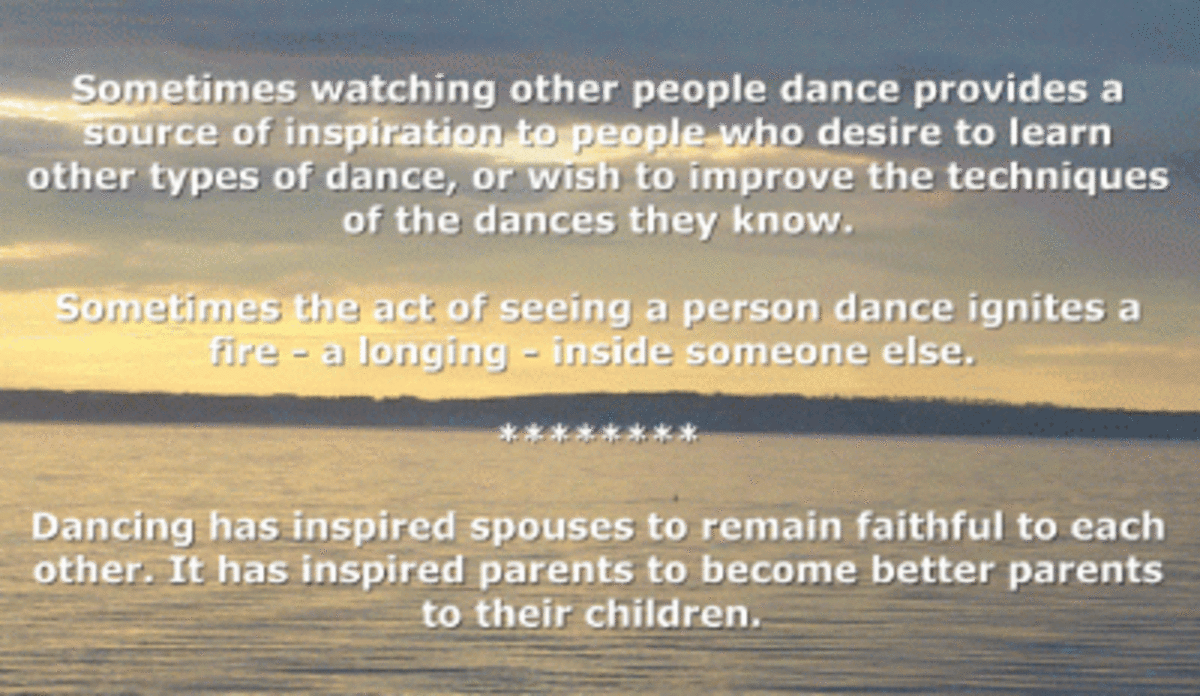7 Important Benefits of Dancing

Dancing Captivates People Everywhere!
What are the benefits of dancing? Is it an act you participate in just to pass the time during the weekend or, possibly, a weeknight? Do you dance so you can feel beautiful and graceful for a change, or does it hold something of more value for you?
What is so important about the act of dancing? Of course, it's an entertaining exercise, but why is it so captivating? Why do you crave "the dance?"
Why do you dance when the music gets into your soul? Why does dancing sometimes make you laugh out loud or lean in close to your dance partner?
Furthermore, what is so special about dancing with someone you love, or even dancing with a stranger? Why does your baby experience much delight when you sway around the room to the music? Why do you get excited and dance for joy?
This article will explore some of the important benefits which abound for dancers, regardless of their age, country of origin, or whether they dance professionally or for fun.
What is so important about the act of dancing? Of course, it's an entertaining exercise, but why is it so captivating? Why do you crave "the dance?"
Why do you dance when the music gets into your soul? Why does dancing sometimes make you laugh out loud or lean in close to your dance partner?
Furthermore, what is so special about dancing with someone you love, or even dancing with a stranger? Why does your baby experience much delight when you sway around the room to the music? Why do you get excited and dance for joy?
This article will explore some of the important benefits which abound for dancers, regardless of their age, country of origin, or whether they dance professionally or for fun.
Dancing: An energizing, captivating experience. We live it! We feel it! We breathe it! We love it! But why?
What Purpose Does Dancing Serve?
Dancing provides many great benefits and, while it's not possible to list them all, some of the greater benefits are listed below:
- Dancing allows one to express oneself.
- A sense of unity is found within the dance.
- Dancing provides physical/mental refreshment and relaxation.
- Laughter and fun — dancing can provide a lot of entertainment.
- Dancing is a form of exercise.
- Dancers find inspiration and motivation as they become lost in the dance.
- Dancing allows professional dancers to form affiliations.
1. Dancing to Express Oneself
Conveying a Message
Dancing allows people to express how they feel at a given moment.
Anyone observing a mother swaying around her house with her baby tucked safely in her arms knows she is experiencing a moment of intense love for her baby while exercising a tender embrace while caught up in the dance.
When a couple is dancing to a slow song and they look into each others' eyes and smile, it's not difficult to realize they feel strong emotions for each other, regardless of whether it's love or lust.
On another note, dance is an expression of art, in that it appeals to the emotions. For example, a girl who pirouettes across a stage while performing ballet appears graceful and elegant to many people, thus emotionally appealing.
A woman who dances slowly in the arms of a man she loves seems enchanted, which brings happiness and, for some people, tears of joy.
Break-dancing involves fluidity of movement which cheers the crowd.
Synchronized background dancers performing the same moves at the same time create excitement and enthusiasm which liven up a crowd, especially if accompanied by upbeat music.
However, an important point to remember is that just because many people enjoy the dances they witness, that doesn't mean everyone is affected the same way. People interpret things differently and, as a result, their emotional responses will differ.
As an example, let's re-visit the little ballet dancer mentioned above. While most of the audience may be enthralled with her graceful performance, for a mother looking on who has lost her daughter, there may be a feeling of sorrow mingled with the joy and awe of the moment.

People Can Dance Almost Anywhere, Anytime.
People dance in many places — at nightclubs and studios, at weddings and on the street. They dance at home and, sometimes, at the workplace. Some even try to dance in their vehicles, though it isn't something that would be recommended.
Of course, there are some types of dancing that children and teens (and adults like myself) should not be privy to but, for most types of dance, there are few restrictions imposed as to where a person can dance and the style of dance they choose.
2. Dancing to Find Unity
A Bond Created or Shared
People come together through dance. It provides entertainment for people of all ages, races, and backgrounds.
They enjoy time spent together in a positive, upbeat environment. They are energized and inspired by other dancers in their midst.
The more adventurous dancers may try to emulate the moves of others, which provides another sense of entertainment and draws people together.
Strangers have the potential to become friends, while families and friends bond more closely because of the positive experiences they've shared on the dance floor.
3. Dancing for Relaxation
Dancing helps bodies and minds relax as the music and surroundings take people away from their anxiety and frustration for a while.
Mentally, they unwind and have fun, sharing a laugh or two. As their minds relax, their bodies follow. Their muscles loosen up and tension and stress melt away.

4. Dancing for Entertainment
The Joys of Dancing
A baby who giggles as his parents take turns dancing him around the house provides a source of entertainment while bringing a sense of joy and peace to the home.
On another note, when people are laughing and trying to keep up with the moves involved in line-dancing, they are being entertained. If they are new at line-dancing, they may be providing entertainment for others. Their willingness to get on the floor and join in with the others, regardless of whether they embarrass themselves, says a lot. They have lots of energy, spunk, and determination, and they are willing to prove it on the dance floor.
5. Dancing for Exercise
Gain Strength and Endurance Through Dancing
Dancing is a great form of aerobic exercise since it works many muscles in the body. Muscles become stretched, conditioned, and toned while the heart rate increases, pumping blood at a faster rate.
As bodies feel the benefit of a workout during the cool-down period, it's a good practice to have a few moments to rest after dancing, especially if it was a fast dance.
Between dances, stretch out leg and arm muscles or, at the very least, sit in a chair and totally relax while rolling the neck slowly around, and then in a slow back and forth motion to release tension which may have built up in the back of the neck.
A great benefit of exercise is that afterward, there is often an improvement in a person's disposition, so it's a win-win situation all the way around.
How many times a week do you dance?

6. Dancing for Inspiration

7. Dancing to Form Affiliations
Forming Affiliations
Professional dancers form affiliations. Some of these people will be seen on stage as background dancers while a singer or group is performing. Sometimes singers themselves dance as part of their performances.
Sometimes a dancer may only be known in a limited number of circles until someone in an audience pays close attention. Overnight, or so it seems sometimes, a dancer goes from an "unknown" to a "star."
Dancing can't help but enhance a performance, and the audience cannot help but pay attention.
Dance: The Universal Language
Dance compliments people with different tastes, emotions, needs, and backgrounds because there is so much variety. As a result, dancing has not only become a universal art form, but a universal language.


Comments